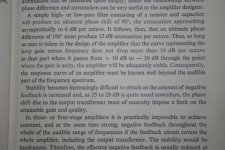Svein_B said:Thank you richwalters
I am not sure however how the philosophy can be applied to the Simple SE, being a circuit without global feedback.
To understand the curves, I figure the rough order of magnitude as follows:
Pulse-width is 250 ms, and x-axis is around 2-3 seconds. The damped resonance will thus be below 1 Hz (motorboating territory). The 5-10nF coupling will in a typical amp give a -3dB point around 50-100 Hz (not considering FB), and -20dB in the 5-10Hz range. I am Confused.
SveinB.
With SE without global nfb the LS relies on the Z step-up brake of the o/p stage tube for damping. With no global nfb the interstage cap values are high in relation to frequency. That's the simplicity of designing a single pole cap/freq droop. >You select an o/p tranny for the whole frequency job. Finished.
If you plot the open loop gain for the whole push-pull amp without global nfb, you will get exactly what you point out (i.e -3dB at 50Hz or loop gain looks like an inverted bath-tub curve). What's the front end tube doing with the global nfb tied to cathode ? = It's working at nearly max gain keeping level up. This is difficult to explain and keeping things simple !
At this point, the global nfb exposes another undesirable, phase shift within the output transformer, so we are back to fundamentals, there is a circuit lag at low frequencies caused by the o/p tranny and this phase difference (called phase angle) determines how much the drift is. I'm only saying in brief what goes on at the LF end. The HF end is more awkward. The conditions for global nfb imply a phase difference of 180° but instability is probable if there is already phase shift with the amp (other circuits) and feedback is close to that figure. So je more stages the more phaseshift there is.
If one can design a two stage 100W amp with global nfb then things couldnt' be better placed..
Gradually leaning toward the math. text in pic.
richj
Attachments
Currently in assembly on my bench is a stereo 100W amp using 6550's in p-p parallel pairs..a big and heavy amp. The electrical/paper design is complete and I will apply my interstage cap findings in relation to LF thd findings. This will tell me alot.
A long winter project.
richj
A long winter project.
richj
- Status
- This old topic is closed. If you want to reopen this topic, contact a moderator using the "Report Post" button.
